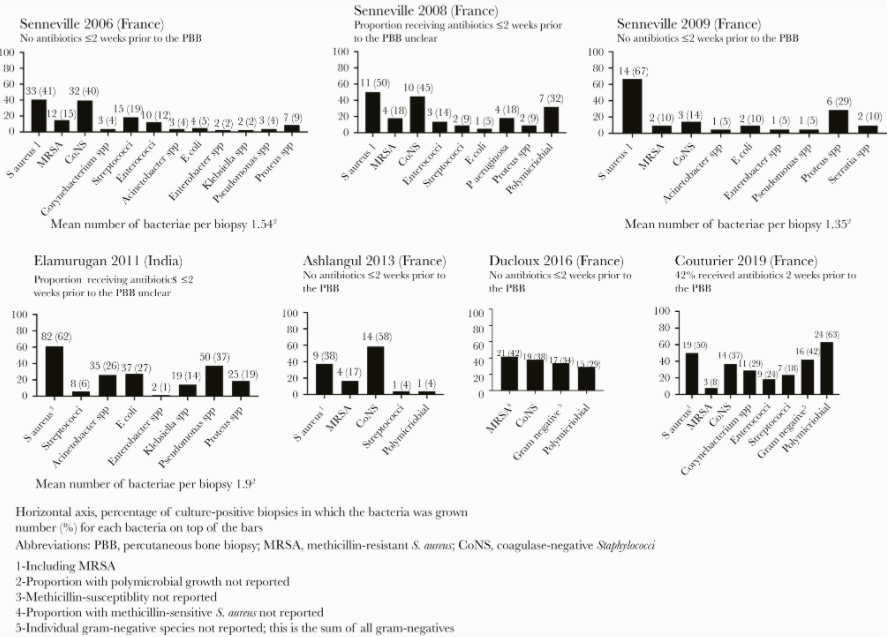
1/N
What is the yield of percutaneous bone biopsy for diabetic foot osteomyelitis? Check our meta-analysis. Honored to have our paper selected as editor's choice for #OFID
@DGArmstrong @PaulSaxMD @CarlosdelRio7 @benjamin_risk
academic.oup.com/ofid/article/7…
What is the yield of percutaneous bone biopsy for diabetic foot osteomyelitis? Check our meta-analysis. Honored to have our paper selected as editor's choice for #OFID
@DGArmstrong @PaulSaxMD @CarlosdelRio7 @benjamin_risk
academic.oup.com/ofid/article/7…

2/N
How many papers are out there reporting on the yield (i.e., proportion that are culture positive) of percutaneous bone biopsy for diabetic foot osteomyelitis?
11 papers (including 2 conf abstract). 10 papers from Europe, 3 from same first author.
How many papers are out there reporting on the yield (i.e., proportion that are culture positive) of percutaneous bone biopsy for diabetic foot osteomyelitis?
11 papers (including 2 conf abstract). 10 papers from Europe, 3 from same first author.

3/N
How many patients and percutaneous bone biopsies for diabetic foot osteomyelitis we found in our systematic review?
780 patients with 837 PBBs - that is not much considering a diabetes-related amputation occurs every 30 seconds globally: pubmed.ncbi.nlm.nih.gov/16291066/
How many patients and percutaneous bone biopsies for diabetic foot osteomyelitis we found in our systematic review?
780 patients with 837 PBBs - that is not much considering a diabetes-related amputation occurs every 30 seconds globally: pubmed.ncbi.nlm.nih.gov/16291066/
4/N
Turns out a large proportion of percutaneous bone biopsies for diabetic foot osteomyelitis are culture-positive:
Range 56%–99%
Pooled proportion 84% (95% Cl, 73%–91%).
Turns out a large proportion of percutaneous bone biopsies for diabetic foot osteomyelitis are culture-positive:
Range 56%–99%
Pooled proportion 84% (95% Cl, 73%–91%).

5/N
That's a very high proportion, much higher than our "guess" and clinical experience from colleagues. So we did a sensitivity analysis (funnel plot) and still found a high pooled proportion (77%).
That's a very high proportion, much higher than our "guess" and clinical experience from colleagues. So we did a sensitivity analysis (funnel plot) and still found a high pooled proportion (77%).

6/N
Some studies did the biopsy through the ulcer (higher risk of contamination?) and others through intact skin (gold standard?). The pooled proportion was slightly higher when done through an ulcer. But the bigger question is which route will yield the "true" pathogens
Some studies did the biopsy through the ulcer (higher risk of contamination?) and others through intact skin (gold standard?). The pooled proportion was slightly higher when done through an ulcer. But the bigger question is which route will yield the "true" pathogens

7/N
What about prior antibiotics? The pooled proportion among studies including patients who received antibiotics <2 weeks prior to the biopsy was higher then studies that excluded patients with recent antibiotics.
Caution!
What about prior antibiotics? The pooled proportion among studies including patients who received antibiotics <2 weeks prior to the biopsy was higher then studies that excluded patients with recent antibiotics.
Caution!

8/N
Studies that included patient with recent antibiotic exposure were also more likely to perform biopsy through an ulcer. Saying prior antibiotics don't mater because proportion culture-positive was similar is a simplistic view.
Which bugs were suppressed? Are pts comparable?
Studies that included patient with recent antibiotic exposure were also more likely to perform biopsy through an ulcer. Saying prior antibiotics don't mater because proportion culture-positive was similar is a simplistic view.
Which bugs were suppressed? Are pts comparable?
9/N
What bugs grew from the biopsies? Lots of S aureus. Not low proportion of Pseudomonas, except for study from India that also may have included patients with recent antibiotic exposure.
What bugs grew from the biopsies? Lots of S aureus. Not low proportion of Pseudomonas, except for study from India that also may have included patients with recent antibiotic exposure.

Final thoughts:
Does this mater? That's complicated. Few studies reporting on outcomes and stewardship. Poor standardization between studies.
Does this mater? That's complicated. Few studies reporting on outcomes and stewardship. Poor standardization between studies.
• • •
Missing some Tweet in this thread? You can try to
force a refresh


